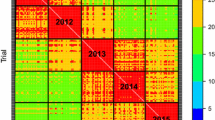Summary
The Australian Cotton Cultivar Trials (ACCT) are designed to investigate various cotton [Gossypium hirsutum (L.)] lines in several locations in New South Wales and Queensland each year. If these lines are to be assessed by the simultaneous use of yield and lint quality data, then a multivariate technique applicable to three-way data is desirable. Two such techniques, the mixture maximum likelihood method of clustering and three-mode principal component analysis, are described and used to analyze these data. Applied together, the methods enhance each other's usefulness in interpreting the information on the line response patterns across the locations. The methods provide a good integration of the responses across environments of the entries for the different attributes in the trials. For instance, using yield as the sole criterion, the excellence of the namcala and coker group for quality is overlooked. The analyses point to a decision in favor of either high yields of moderate to good quality lint or moderate yield but superior lint quality. The decisions indicated by the methods confirmed the selections made by the plant breeders. The procedures provide a less subjective, relatively easy to apply and interpret analytical method of describing the patterns of performance and associations in complex multiattribute and multilocation trials. This should lead to more efficient selection among lines in such trials.
Similar content being viewed by others
References
Basford KE (1982) The use of multidimensional scaling in analysing multi-attribute genotype response across environments. Aust J Agric Res 33:473–480
Basford KE, McLachlan GJ (1985a) The mixture method of clustering applied to three-way data. J Classification 2:109–125
Basford KE, McLachlan GJ (1985b) Likelihood estimation with normal mixture models. Appl Stat 34:282–289
DeLacy IH (1981) Cluster analysis for the interpretation of genotype by environment interaction. In: Byth DE, Mungomery VE (eds) Interpretation of plant response and adaptation to agricultural environments. Queensland Branch, Australian Institute of Agricultural Science, Brisbane, pp 277–292
Dempster AP, Laird NM, Rubin DB (1977) Maximum likelihood from incomplete data via the EM algorithm (with discussion). J R Stat Soc B 39:1–38
Gabriel KR (1971) The biplot graphical display of matrices with applications to principal components. Biometrika 58:452–462
Harshman RA, Lundy ME (1984) Data preprocessing and the extended PARAFAC model. In: Law HG, Snyder CW Jr, Hattie JA, McDonald RP (eds) Research methods for multimode data analysis. Praeger, New York, pp 216–284
Kempton RA (1984) The use of bi-plots in interpreting variety by environment interactions. J Agric Sci 103:123–135
Kroonenberg PM (1983) Three-mode principal component analysis: Theory and applications. DSWO Press, Leiden
Kroonenberg PM, Basford KE (1989) An investigation of multiattribute genotype response across environments using three-mode principal component analysis. Euphytica 44:109–123
Kroonenberg PM, Brouwer P (1985) User's guide to TUCK-ALS3 (version 4.0). Technical report, University of Leiden, Department of Education
Kroonenberg PM, De Leeuw J (1980) Principal component analysis of three-mode data by means of alternating least squares algorithms. Psychometrika 45:69–97
McLachlan GJ, Basford KE (1988) Mixture models: Inference and applications to clustering. Marcel Dekker, New York
Reid PE, Thomson NJ, Lawrence PK, Luckett DJ, McIntyre GT, Williams ER (1989) Regional evaluation of cotton cultivars in eastern Australia 1974–1985. Aust J Exp Agric 29:679–689
Tucker LR (1966) Some mathematical notes on three-mode factor analysis. Psychometrika 31:279–311
Williams WT (ed) (1976) Pattern analysis in agricultural science. Elsevier, Amsterdam
Wolfe JH (1971) A Monte Carlo study of the sampling distribution of the likelihood ratio for mixtures of multinormal distributions. Technical Bulletin STB 72–2. U.S. Naval Personnel and Training Research Laboratory, San Diego
Author information
Authors and Affiliations
Additional information
Communicated by A.R. Hallauer
Rights and permissions
About this article
Cite this article
Basford, K.E., Kroonenberg, P.M., DeLacy, I.H. et al. Multiattribute evaluation of regional cotton variety trials. Theoret. Appl. Genetics 79, 225–234 (1990). https://doi.org/10.1007/BF00225956
Received:
Accepted:
Issue Date:
DOI: https://doi.org/10.1007/BF00225956




